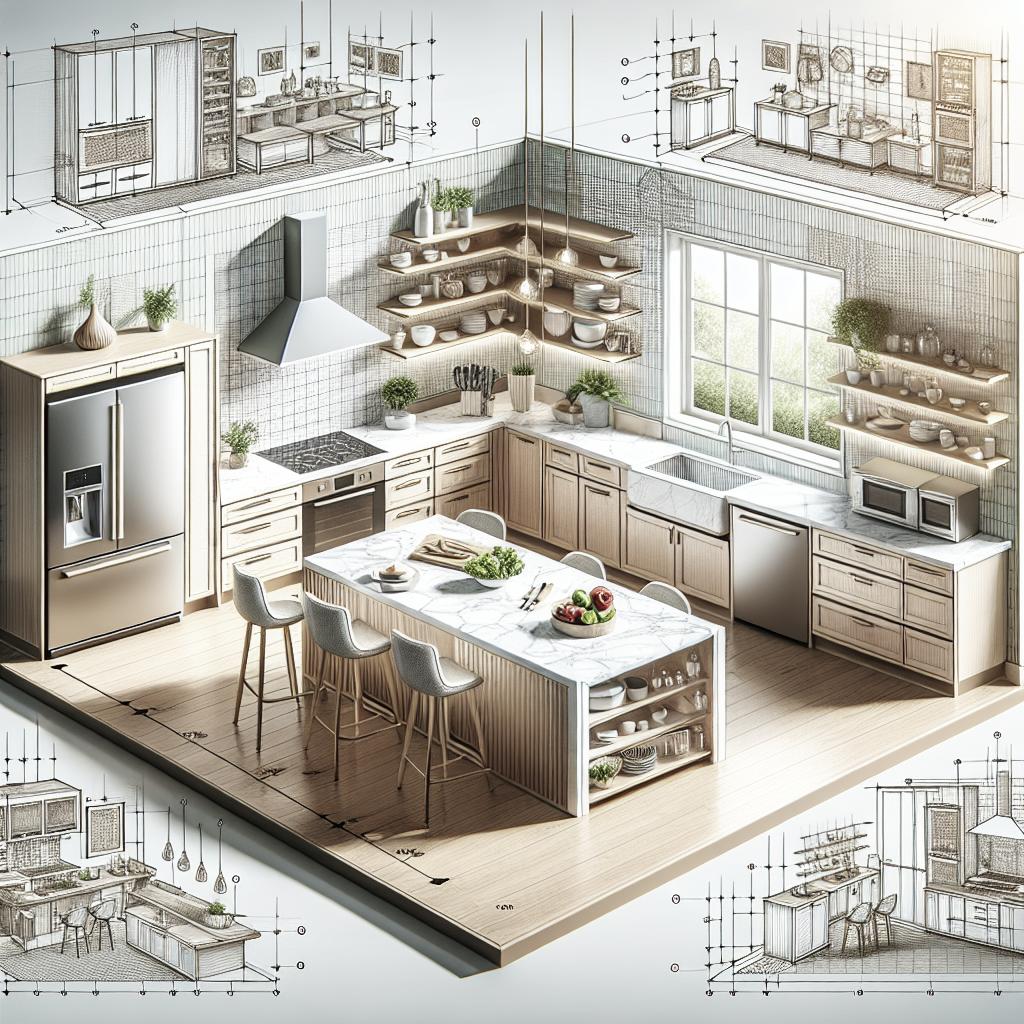“`html
Designing a Functional Kitchen Layout
Creating a functional kitchen layout is a crucial step in ensuring the efficiency and comfort of your cooking space. The kitchen is often the heart of the home, serving as a hub for cooking, dining, and socializing. This blog post will delve into essential elements such as the practical design of the kitchen triangle, the emerging concept of workstations, the strategic positioning of an island, and how lighting influences functionality. By exploring these aspects, we aim to provide a comprehensive guide to assist you in crafting the kitchen of your dreams that isn’t just aesthetically pleasing but also optimally serves your needs. Join us as we walk through essential guidelines and blueprint features, ensuring every square foot counts.
Related To:
When devising a kitchen layout, it’s essential to consider how the design relates to the surrounding spaces in your home. The kitchen’s position within the home can significantly affect its functionality and how it serves the household’s activities. If your kitchen opens into a living or dining area, it can create an inviting environment perfect for entertaining guests while maintaining easy access to kitchen facilities.
Additionally, considering storage spaces, adjacent rooms, and entry points will help ensure that your kitchen seamlessly integrates into the overall home layout. Ensuring easy access to the kitchen from entryways or the backyard can streamline carrying groceries inside or serving meals outside.
Make It Work
The first step in designing a functional kitchen is to focus on practicality. Start by considering the workflow — the typical path one follows when preparing meals. Think about the placement of the sink, stove, and refrigerator, the key components of the classic kitchen triangle. This triangle shouldn’t be interrupted by traffic zones; it should facilitate the cook’s movement effortlessly.
It’s important to tailor your kitchen layout to your daily routines. For instance, if you frequently bake, ensure your oven and prep areas are conveniently placed. Similarly, coffee enthusiasts might prioritize proximity to a dedicated coffee-making space. Adapting the layout to suit your lifestyle enhances functionality and satisfaction.
Check Out the Guidelines
Implementing design guidelines ensures that your kitchen is both comfortable and efficient. For instance, counter height and depth should align with cooking and serving needs, which can vary based on the primary cook’s preferences. Adequate clearance space between cabinets and appliances ensures unimpeded movement and access.
Safety guidelines also play a crucial role. Heat-producing appliances should be placed at safe distances from windows or flammable materials, and designing with children or elderly family members in mind can prevent accidents. Incorporating wide walkways ensures that multiple people can navigate the space safely and comfortably.
Triangle vs. Workstation
The kitchen triangle principle has been a cornerstone of kitchen layout design. This concept arranges the sink, stove, and refrigerator in a triangular shape to optimize functionality and decrease walking time. It is particularly effective in smaller kitchens or kitchens where a single person does most of the cooking.
However, modern kitchens increasingly embrace the workstation approach. This method groups similar tasks together and allocates dedicated zones for prep, cooking, and cleanup. As homes evolve and kitchens become multifunctional spaces, the workstation concept accommodates multiple cooks or specific culinary interests better than the traditional triangle.
Island Location
A kitchen island can be a versatile asset if used correctly. Its location should facilitate ease of movement and access around the kitchen. Placement of an island should complement the shape of the kitchen, allowing at least 3 feet of space around it for free-flowing movement.
Consider the purpose of the island: is it for additional prep space, housing appliances, or casual dining? Incorporate multifunctionality to maximize value, such as combining seating with storage opportunities. For larger kitchens, a well-placed island serves as a central gathering point, enhancing social interactions without interrupting the chef’s work.
Keep It Light
Lighting plays a critical role in kitchen design, impacting both aesthetics and functionality. Bright, evenly distributed lighting minimizes shadows, improving visibility and safety while cooking. Under-cabinet lighting is an excellent addition to illuminate countertops and work areas.
Natural light should be maximized wherever possible, creating a warm, inviting atmosphere. Reflective surfaces like glossy backsplashes or polished countertops can enhance light dispersal. Finally, adjustable lighting options allow you to set an appropriate mood for various occasions, from bright task-focused light to softer tones for dining.
Kitchen Blueprint
Designing a kitchen blueprint is an intricate process that ensures every element fits harmoniously within the available space. Start by measuring the kitchen dimensions, noting major architectural features and fixed elements like doors and windows. Ensure your desired layout aligns with these pre-existing features.
Create a scaled drawing to visualize the layout, paying attention to appliance placements, storage solutions, and counter space distribution. Adaptability is key, so remain open to modifications that optimize flow or accommodate new suggestions from design professionals.
Lessons Learned:
| Aspect | Key Points |
|---|---|
| Related To | Consider kitchen relation to home layout; ensure accessibility and integration. |
| Make It Work | Design for workflow efficiency; align with daily routines for maximum convenience. |
| Check Out the Guidelines | Follow design and safety guidelines; ensure comfortable and safe usage. |
| Triangle vs. Workstation | Choose between traditional triangle or workstation approach for optimal usage. |
| Island Location | Strategically place island for utility and accessibility; consider multifunctionality. |
| Keep It Light | Leverage lighting to enhance both function and ambiance; utilize natural light. |
| Kitchen Blueprint | Draft a well-considered layout; remain open to adjustments as needed. |
“`
